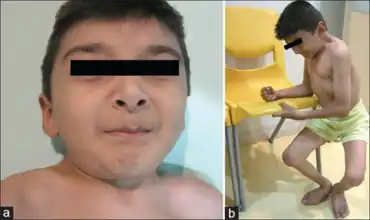Schwartz–Jampel syndrome
| Schwartz–Jampel syndrome | |
|---|---|
| Other names: Myotonic myopathy, dwarfism, chondrodystrophy, ocular and facial anomalies, Dysostosis enchondralis metaepiphysaria, Catel-Hempel type | |
 | |
| Schwartz–Jampel syndrome is inherited in an autosomal recessive manner. | |
| Specialty | Orthopedic |
Schwartz–Jampel syndrome (SJS) is a rare genetic disease caused by a mutation in the perlecan gene (HSPG2)[1] which causes osteochondrodysplasia associated with myotonia.[2] Most people with Schwartz–Jampel syndrome have a nearly normal life expectancy.[3]
Signs and symptoms

The clinical presentation of this condition is as follows:[3]
- Drooping lower lip
- Full cheeks
- Abnormal gait
- Hip dysplasia
- Abnormality of epiphysis morphology
- Abnormality of the metaphysis
- Joint stiffness
- Coxa vara
- Flat facial shape
- Flexion contracture of toe
- High palate
- Hip contracture
- Hyporeflexia
Cause
Schwartz–Jampel syndrome is caused by mutations in the HSPG2 gene, which makes the protein perlecan, which is found in muscle and cartilage.[3] Relationships between the disease and perlecan deficiency have been studied.[4] In Schwartz–Jampel syndrome, it is suspected that abnormal perlecan function leads to a deficiency in acetylcholinesterase, an enzyme involved in breaking down the neurotransmitter acetylcholine, which incites muscle contraction. If acetylcholine is not broken down, it can lead to prolonged muscle contraction/stiffening of the muscles (myotonia).[3]
Diagnosis
Schwartz–Jampel syndrome is diagnosed on the basis of characteristic facial features, skeletal features and myotonia. Blood tests may show elevated serum creatine kinase or aldolase. X-rays, muscle biopsy or electromyography (EMG) may be useful. Genetic testing for the HSPG2 gene may confirm diagnosis.[3]
Treatment
There is no cure for Schwartz–Jampel syndrome. Treatment is aimed at reducing muscle stiffness and cramping and may include massage, muscle warming and gradual strengthening exercises. Muscle relaxants or anti-seizure medications, especially carbamazepine, may be used. Eye symptoms such as blepharospasm might be relieved by Botox. Otherwise, a variety of surgical procedures have been found to be effective. Malignant hyperthermia, a potential complication of surgery, is a greater risk for people Schwartz–Jampel syndrome and an important consideration when considering surgery.[3]
Prognosis
Most people with Schwartz–Jampel syndrome have a nearly normal life expectancy.[3]
History
The syndrome was first described in 1962 by American ophthalmologist Oscar Schwartz and American neuro-ophthalmologist Robert Steven Jampel.[5][6]
Society
In March 2013, there was media coverage on a British 7-year-old boy with chronically tense muscles due to SJS, and his three-legged pet dog. They became first-place winners of the 2013 Crufts Kennel Club's annual Friends for Life competition, which "celebrates dogs that have truly earned the title of man’s best friend through bravery, support or companionship".[7][8][9] The dog was also awarded The Braveheart Honour in the ceremony of The British Animal Honours in April 2013 (Haatchi the dog). The two are featured in the book Haatchi & Little B (2014, ISBN 125-006-936-X) by Wendy Holden[10]
References
- ↑ "Schwartz Jampel syndrome type 1". National Center for Advancing Translational Sciences. Archived from the original on 27 February 2014. Retrieved 20 February 2014.
- ↑ Mallineni, Sreekanth K.; Yiu, Cynthia K. Y.; King, Nigel M. (June 2012). "Schwartz-Jampel syndrome: a review of the literature and case report". Special Care in Dentistry. 32 (3): 105–111. doi:10.1111/j.1754-4505.2012.00249.x. PMID 22591433.
- 1 2 3 4 5 6 7 "Schwartz Jampel syndrome | Genetic and Rare Diseases Information Center (GARD) – an NCATS Program". rarediseases.info.nih.gov. Archived from the original on 2021-03-18. Retrieved 2018-03-05.
- ↑ Stum, M; Davoine, CS; Fontaine, B; Nicole, S (Oct 2005). "Schwartz-Jampel syndrome and perlecan deficiency". Acta Myologica. 24 (2): 89–92. PMID 16550923.
- ↑ Ault, Jennifer (2012-02-01). "Schwartz-Jampel Syndrome". Medscape. Archived from the original on 2021-03-09. Retrieved 2021-08-30.
- ↑ Schwartz, O; Jampel, R. S. (1962). "Congenital blepharophimosis associated with a unique generalized myopathy". Archives of Ophthalmology. 68: 52–7. doi:10.1001/archopht.1962.00960030056011. PMID 13909723.
- ↑ Owen and Haatchi win Friends for Life at Crufts 2013 Archived 2019-03-27 at the Wayback Machine, Crufts.org, 10 March 2013
- ↑ Crufts bravery award win for three-legged dog Haatchi Archived 2021-03-05 at the Wayback Machine, BBC News, 11 March 2013
- ↑ Three-Legged Dog, Haatchi, Wins 'Friends For Life' Crufts Award For 7-Year-Old Owner, Owen Archived 2021-02-28 at the Wayback Machine, Huffingtonpost, 10 March 2013
- ↑ "Haatchi & Little B". Wendy Holden. Archived from the original on October 25, 2020. Retrieved March 8, 2019.
External links
| Classification | |
|---|---|
| External resources |
|